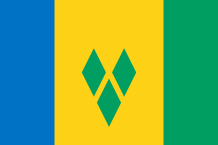ST VINCENT & THE GRENADINES
 St Vincent and The Grenadines represent 389 sq km. St Vincent is 90% of the country with 345 sq km ; the rest of the area is shared out between 31 rocks and little islands ; Mustique, Canouan, Mayreau, Bequia and Union Island are among a dozen inhabited islands.
St Vincent and The Grenadines represent 389 sq km. St Vincent is 90% of the country with 345 sq km ; the rest of the area is shared out between 31 rocks and little islands ; Mustique, Canouan, Mayreau, Bequia and Union Island are among a dozen inhabited islands.
St Vincent is a luxuriant volcanic island. In the north, there are Morne Garu Mountains with Richmond Peak (1073m) and Mount Brisbane ; Waterloo Mountains with La Soufrière, an active volcano that is the highest point of the island (1234m). In May 1902, La Soufrière erupted and killed 2000 inhabitants. In April 1979, the volcano spat a lot of ash and 20 000 people were evacuated.
The centre of St Vincent is occupied by a tropical forest. In the valleys grow coconut palms, banana trees, morantes etc.
The Grenadines are surrounded by a coral barrier ; these islands do not have river or drinking water spring. Some of them have small valleys.
Several species of bird nest in St Vincent. The endangered St Vincent Amazon parrot is the national bird. Adult, it can reach 45cm long. Other animals like the opossum (manicou), the agouti, 3 species of harmless snake (the black snake, the white snake and the Congo snake) live in the forest.
Agriculture is a main economic activity. Banana, spices, cocoa and arrow-root are exported. St Vincent is the world’s first marante producer. The island also produces flowers, fruits and vegetables. Growing of sugar cane has been stoped, in 1995.
In The Grenadines, tourism is an important economic sector.
Colonization of St Vincent by the Europeans was not easy. Indeed, the Carib Indians who had already killed or expeled the Arawak Indians from the island fought furiously against the Spanish explorers. So, they decided to leave this land. In 1675, a Dutch ship which transported African slaves sank between St Vincent and Bequia. No European survived but many Africans swam until the shore. The Caribs accepted them and allowed them to marry their women. Their descendants were called “Black Caribs”, the native Caribs were named “Yellow Caribs”.
In 1770, the Caribs allowed the first European colonists – The French – to settle in St Vincent because they did not want to appropriate their island (like the English). Unfortunatly, by the Treaty of Paris in 1783, France gave up St Vincent to Great Britain. This decision caused many revolts. In 1795, Yellow Caribs and Black Caribs, helped by the French settlers, murdered many British colonists. During a duel with the British captain, Alexander Leith, Chattawae, the Black Caribs’ leader was killed. In 1797, the British army arrested the rebels then, exiled about 5 000 Caribs to Roatán island (Honduras). Some Caribs which did not participate in the revolt were led to Sandy Bay situated on the Saint Vincent’s northeast coast.
The settlers continued getting richer thanks to the labour of African slaves. In 1802, the eruption of La Soufrière destroyed many plantations and killed Caribs in Sandy Bay’s reservation (in the north-east). In 1834, almost 20 000 Africans were freed after the end of slavery. Portuguese then indians workers replaced them on the plantations.
In 1969, the island became autonomous. Since October 27, 1979, St Vincent and The Grenadines are an independent state that belongs to the Commonwealth.
A Prime Minister leads the country.
Area : 389 sq km (150 sq miles)
Population : 103 000 inhabitants
Capital : Kingstown
Languages : English (official) – Creole (dying)
Money : Eastern Caribbean Dollar (EC$)
People : Vincentians
